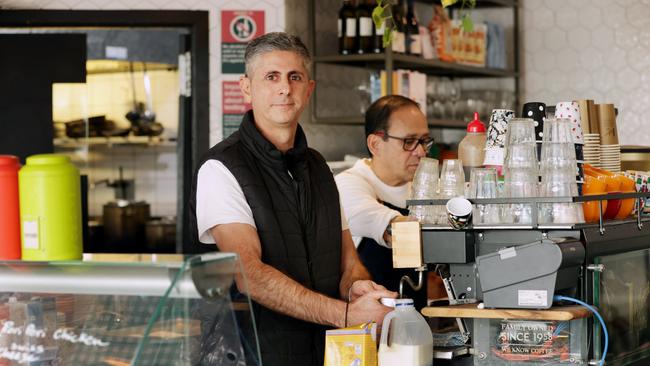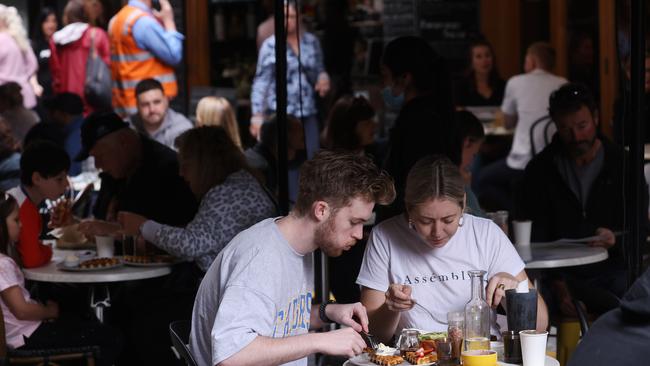Twice as many hospitality businesses going under versus a decade ago
Could you soon pay $100 for steak & chips? As hospitality businesses fail at nearly twice the rate of a decade earlier, industry players sound a warning on cafes and restaurants.

Hospitality businesses are failing at nearly twice the rate of a decade earlier, as industry players warn that soaring food and energy prices are pushing an increasing number of cafes and restaurants to the brink of collapse.
Independent Food Distributors Australia chief executive Richard Forbes said restaurant suppliers had typically experienced a 30 per cent increase in average food costs over the past three years, even as rents and insurance costs had doubled.
Mr Forbes said these surging energy bills and food prices were making many retail clients “inviable” as restaurants and cafes struggled to pass on higher costs to increasingly thrifty customers.
IFDA’s members provide food to 60,000 cafes, restaurants, pubs and clubs, as well as thousands of hospitals, nursing homes, and schools.
“Without the government reining in inflation, the number of businesses going broke will continue in food service,” said, Mr Forbes, who alongside industry leaders last week met with Small Business Minister Julie Collins, Peter Dutton, and independent senator David Pocock.
“Are we heading for $10 cappuccinos and $100 steak & chips? The government must urgently think of ways to make energy costs as cheap as possible for those in the food service supply chain.”
The warnings come as Australian Securities & Investments Commission figures show nearly 1600 businesses in the accommodation and food services sector went under during the past financial year.
The number of companies going bust was 50 per cent higher than in 2018-19 – the last financial year leading into the pandemic – and 90 per cent more than in 2013-14, when the corporate regulator began reporting corporate failures by industry.
In contrast, total insolvencies excluding accommodation and food services are roughly 25 per cent above where they were pre-Covid, and virtually unchanged from a decade earlier, according to analysis by The Australian.
George Dannaoui, co-director of cafe and caterer The Moody Chef in Sydney, says his business is experiencing pain on all fronts, from creeping energy prices to food and packaging costs.

In the past year, the business has seen a doubling of costs for cheese and other dairy products and have been quoted $4 for a burger patty that used to cost $1.80. Mr Dannaoui says he is constantly having to review his business model and he is making changes such as opening the cafe, which operates on weekdays, on Saturdays as well as changing the menu to offer more baked goods and a smaller range of cooked dishes to save on labour costs.
“We’ve tweaked costs on every front, we’re looking at winding things down because you can’t keep pressing the customer for more money and more money,” Mr Dannaoui told The Australian.
“You can go through the whole pantry and everything has just gone up. It’s actually frightening because there doesn’t seem to be any light at the end of the tunnel.”
He said there was a lot of anxiety around rising costs, inflation and the bird flu. “You put one fire out, there’s another one,” he said.
“You’ve got the mental trauma that comes on the back of that anxiety, which is really hard for a lot of people. We need the government to rise to the task. We need them to acknowledge that behind every shop is a family.”

While The Moody Chef has been operating for 20 years and has an established patronage, Mr Dannaoui said it was “frightening” for businesses that had opened in the past five years.
He said on top of rising costs, he has also noticed consumer spending decline. “Retail is challenging; we’re just hoping people are going to come down for a coffee or a muffin,” Mr Dannaoui said.
“I’ve got customers who used to have a quiche or muffin and coffee now just get a coffee. Sometimes people who used to go in multiple times a week just come in once.”
The business owner said governments should step in and help cafes and restaurants by bringing back dine and discover vouchers, drop fees associated with outdoor dining permits and make land tax exemptions for struggling industries.
Mike Peberdy, the owner of Moco Food Services, a family-owned restaurant supplier that operates in southeast Queensland and northern NSW, said firms were being hammered with higher costs right down the supply chain, and that this was leading to higher prices in restaurants, cafes and supermarkets.
Mr Peberdy, whose business employs 350 people, said “state and federal governments are not being sincere in their efforts to reduce the cost of living”.

“Including state and federal charges, our effective tax rate is 45 per cent,” he said.
“Governments should be looking at reducing taxes on fuel and payrolls – and do more to lower energy bills – in order to alleviate pressures on suppliers and ultimately help lower prices for consumers.”
“If they took some action to genuinely reduce inflation, like cutting payroll taxes, then that would improve our competitiveness and productivity, and we would ultimately be supporting thriving industries and a lower cost of groceries for the average Australian.
“We need a real reset on how we tax businesses, because ultimately, it does affect the consumer.”
Recent data from the Australian Bureau of Statistics shows that monthly household spending in hotels, cafes and restaurants has dropped by 13 per cent since the end of last year, slightly outpacing the overall drop in spending.
Restaurant and Caterers Association chief executive Suresh Manickam said many of his members “were saying it’s the toughest they have seen in their years of doing business, and many have been in business for 10 or more years”.
Even as restaurant and cafe owners struggle to cope with a major rise in operating costs, they have also been hit with falling demand as households have looked to cut back on luxuries like eating out.
“Everybody has less money in their pocket these days, so there is an issue in our ability to spend. I don’t know anybody who feels wealthier today than two years ago,” Mr Manickam said.
Skills shortages have fed into a rising wages bill, amplified by large increases to minimum and award wages granted by the Fair Work Commission, he said.
The restaurant and catering industry was calling for more ongoing government support to offset sky-high energy costs, as well as more assistance to attract and train workers.
“We are asking for an investment in apprentices and trainees, and for that investment to come sooner rather than later,” Mr Manickam said.





To join the conversation, please log in. Don't have an account? Register
Join the conversation, you are commenting as Logout